April 24, 2015 at 5:13 pm
By rsdemott
|
Posted in Uncategorized
|
November 21, 2014 at 12:39 pm
Check out this amazing data visualization that NASA has put together showing the movement of carbon dioxide through the atmosphere over the whole Earth for one year. Be sure to note how much the emissions in the northern hemisphere are reduced in the summertime!
Visit NASA's website for a description of how the data was compiled.
By rsdemott
|
Posted in Uncategorized
|
November 3, 2014 at 10:23 am
![IMG_0081[1]](/rsdemott/files/2014/11/IMG_00811-300x225.jpg) A new experiment is currently being constructed at Hubbard Brook. This is a collaboration of Lindsey Rustad of the USDA Forest Service, Heidi Asbjorsen of UNH, and Pam Templer of Boston University. The idea is to manipulate the amount of precipitation reaching the forest floor and to explore how this change impacts forest ecosystem function. The amazing team at Hubbard Brook just completed the frame infrastructure last week! There will be gutters placed on top of these boards to divert rainwater as it falls through the forest canopy. This will reduce the actual amount of precipitation experienced by the forest within the plots. So cool!
A new experiment is currently being constructed at Hubbard Brook. This is a collaboration of Lindsey Rustad of the USDA Forest Service, Heidi Asbjorsen of UNH, and Pam Templer of Boston University. The idea is to manipulate the amount of precipitation reaching the forest floor and to explore how this change impacts forest ecosystem function. The amazing team at Hubbard Brook just completed the frame infrastructure last week! There will be gutters placed on top of these boards to divert rainwater as it falls through the forest canopy. This will reduce the actual amount of precipitation experienced by the forest within the plots. So cool!
By rsdemott
|
Posted in Uncategorized
|
October 28, 2014 at 10:30 pm
![IMG_0072[1]](/rsdemott/files/2014/10/IMG_00721-e1414548172640-225x300.jpg) Today I collected lots and lots of leaves from all the saplings in our climate change project here at Hubbard Brook. In this experiment we have lots of individual young trees which are experiencing temperature manipulations in both summer and winter. One of our hypotheses is that these treatments will affect the productivity of these trees. One really great way to measure productivity is to collect all the leaves that fall off of trees in the autumn. I placed netting around each individual tree so that I could get productivity estimate from individual! Since it has been so rainy for the past two weeks, the leaves are a little bit wet. I've set them out to dry in paper bags on the porch at Pleasant View Farm. (There is one bag per tree, and this isn't even 50% of them!) Once they are air-dry, I'll bring them back to the lab and oven-dry them remove any remaining water. Then I will weigh them and find out the dry mass of leaves produced this year by every single sapling.
Today I collected lots and lots of leaves from all the saplings in our climate change project here at Hubbard Brook. In this experiment we have lots of individual young trees which are experiencing temperature manipulations in both summer and winter. One of our hypotheses is that these treatments will affect the productivity of these trees. One really great way to measure productivity is to collect all the leaves that fall off of trees in the autumn. I placed netting around each individual tree so that I could get productivity estimate from individual! Since it has been so rainy for the past two weeks, the leaves are a little bit wet. I've set them out to dry in paper bags on the porch at Pleasant View Farm. (There is one bag per tree, and this isn't even 50% of them!) Once they are air-dry, I'll bring them back to the lab and oven-dry them remove any remaining water. Then I will weigh them and find out the dry mass of leaves produced this year by every single sapling.
By rsdemott
|
Posted in Uncategorized
|
October 23, 2014 at 10:04 pm
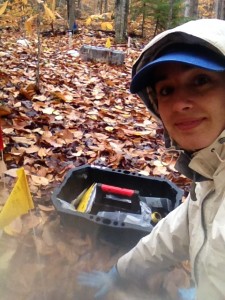
Happy and dry in my rain gear!
Today was a rainy day up at Hubbard Brook and I was out digging up data on how much nitrogen is moving down through the soil, past the roots, and likely out of the ecosystem. To do this, we bury ion-exchange resin bags in the soil below the rooting zone. These are water permeable nylon bags filled with small beads that have been chemically charged to attract positive and negative ions. As water flows through the soil, it moves through these bags and the ions in the water get trapped on the beads. We can then bring the bags back to the lab and analyze the chemicals that have been intercepted.
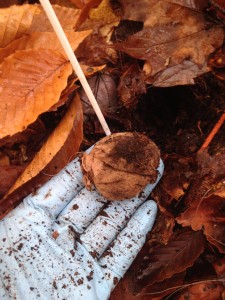
A resin bag being excavated from the soil. The location of the bag is marked by a flag and we tie fishing line to the bag to help retrieve it.
For this project, we are interested in how our temperature treatments impact the amount of inorganic nitrogen moving through the soil. Tomorrow morning, I will extract the ions from the beads and then analyze for ammonium and nitrate content. These particular bags were first placed in the field back in June. They will provide us with an estimate for the rate of nitrogen leaching from June - October.
By rsdemott
|
Posted in Uncategorized
|
October 10, 2014 at 10:15 pm
By rsdemott
|
Posted in Uncategorized
|
October 7, 2014 at 3:19 pm
BU Today has written a great profile of two of our undergraduate research assistants who have been collecting data for our climate change projects at Hubbard Brook. Check it out!
Both Risa McNellis and Taylor Barrow worked with us this summer through BU's Undergraduate Research Opportunities Program (UROP), along with Darian Marinas from Ohio State. They'll all present their findings from this summer next week at the annual BU UROP Symposium.
BU Today: Wiring the Woods

Photo Credit: Cydney Scott

Photo credit: Cydney Scott

Photo credit: Cyndey Scott
By rsdemott
|
Posted in Uncategorized
|
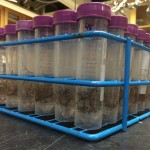
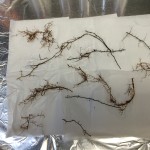
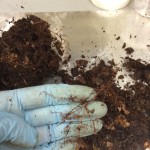
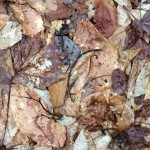
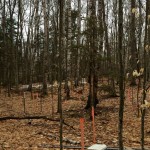
![IMG_0081[1]](/rsdemott/files/2014/11/IMG_00811-300x225.jpg)
![IMG_0072[1]](/rsdemott/files/2014/10/IMG_00721-e1414548172640-225x300.jpg)


![IMG_0010[1]](/rsdemott/files/2014/10/IMG_00101-300x225.jpg)


